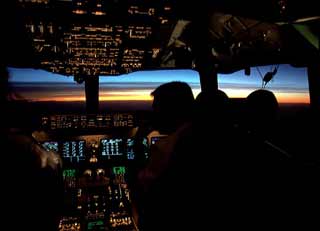|
|
|
Commerical Jet Travel in the Super70sBy Patrick Mondout
The age when only the wealthy traveled through the air ended with deregulation,
but this was not the only innovation that transformed air travel in the
Super70s. Some of the biggest, sexiest, and most popular civilian aircraft
off all-time flew for the first time in our favorite decade.
We're talking about aircraft such as the Boeing
747, Concorde,
McDonnell Douglas DC-10,
and the Lockheed L-1011
TriStar). We're also talking about the planes that were still in the
sky from the beginning of the jet era
(included a special look back on the jet that started it all: the de
Havilland Comet) through the sixties. In addition to those above, we
also cover the 707, 720,
737, A300, A310,
BAC-111, Caravelle,
Convair-880, Convair-990,
DC-8, DC-9,
VC10, as well as Soviet aircraft such as
the Tu-134, Tu-144,
Tu-154, and the Il-62.
(You can choose an aircraft from the drop down list on the far left of any
of our aviation pages.) We also have aircraft
of the 1980s.
Of course someone has to fly all these wonderful machines. From the
small regional carriers like PSA and Southwest
that grew up after deregulation to
the major US carriers like Eastern, Delta
and TWA to the international airlines such
as KLM, BOAC
and El Al, we're covering as many
airlines as we can! (See list below.)
The introduction of the wide-body aircraft in the early Super70s made
higher death counts in aviation accidents inevitable. By the end of the
decade, all 10 of the top 10 worst aviation disasters
had taken place in the previous 10 years. (You might think that is always
the case, but by the end of the Awesome80s, four accidents from the
Super70s were still on the list including what remains the worst
of all time.) Take a look at our list of some of
the worst disasters with links to 50 selected accident reports.
And no look at commercial aviation in the Super70s would be complete
without an article on
D.B. Cooper's exploits.
Navigation note: Throughout these pages you will see a pair of drop
down lists on the far left of the page for both aircraft and airlines.
These should help you navigate through the major airlines and jets we are
covering.
 |
|
Airnikon |
|
 |
 |
|
We'd like to thank Airnikon
for allowing us to use many of his great pictures.
Our aviation sections would be far less colorful
without his contributions. Thanks Mike!
Image courtesy of AirNikon.
Find more of his photos at Airliners.net |
|
|
|
We've received permission from NASA to include a number of articles first
commissioned by and first appeared on NASA's U.S. Centennial of Flight
web site. We gratefully acknowledge the authors, the commission, and NASA.
|
| References:
Heppenheimer,
T.A. Turbulent Skies. New York: John Wiley & Sons, Inc.1995.
Montgomery, Jeff, executive editor. Aerospace: The Journey of Flight.
Maxwell Air Force Base, Alabama: Civil Air Patrol, 2000.
Pattillo,
Donald M. Pushing the Envelope: The American Aircraft Industry. Ann
Arbor, Mich.: University of Michigan Press, 1998.
Rodgers,
Eugene. Flying High: The Story of Boeing and the Rise of the Jetliner
Industry. New York: The Atlantic Monthly Press, 1996.
Serling,
Robert J. Legend and Legacy: The Story of Boeing and Its People. New
York: St. Martin's Press, 1992.
Gunston,
Bill. The Illustrated Encyclopedia of Commercial Aircraft. New York:
Phoebus Publishing Co., 1980.
Mansfield, Harold. Vision, the Story of Boeing. New York: Madison
Publishing, 1986.
Sabbagh,
Karl. Twenty-First Century Jet: The Making and Marketing of the Boeing 777.
New York: Scribner, 1996. |
|
|
|
|
|
|
|
|
.gif)
.gif)



.gif)
KLM(AirNikon)(180).jpg)
